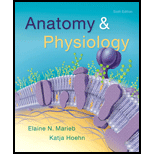
Body water content is greatest in (a) infants, (b) young adults, (c) elderly adults.
Introduction:
Two major fluid compartments are present in human body, one is intracellular fluid (ICF) and second is the extracellular fluid (ECF). Two third (2/3) of the total body water is present in ICF, whereas ECF only accounts for the remaining one third (1/3) of total body water. The ECF is further divided into two parts interstitial fluid (75%) and plasma (25%). The concentration of total body water varies between children and adults, depending on the age group.
Answer to Problem 1MC
Correct answer:
The highest water content is present in infants.
Explanation of Solution
Explanation for the correct answer:
Infants and children posses higher water content in the body. They have higher metabolic rates and increased body surface area to mass index, which makes higher turnover of fluids and solutes. Thus, infants and children require more water compare to the adults. Infants constitute 70% water content of their body weight. Hence option (a) is the correct option.
Explanation for the incorrect answers:
Option (b) states that young adults contain highest water content, which is a false statement as infants constitute 70% - 80% water content of their body weight that is greater than young adults (around 60-65%).
Option (c) states that elderly adults contain highest water content, which is a false statement as infants constitute 70% water content of their body weight that is greater than alderly adults (around 50-60%).
Thus it is concluded that highest water content is present in infants i.e. 70% - 80% water content of their total body weight.
Want to see more full solutions like this?
Chapter 25 Solutions
Anatomy & Physiology (6th Edition)
- please fill in the empty sports, thank you!arrow_forwardIn one paragraph show how atoms and they're structure are related to the structure of dna and proteins. Talk about what atoms are. what they're made of, why chemical bonding is important to DNA?arrow_forwardWhat are the structure and properties of atoms and chemical bonds (especially how they relate to DNA and proteins).arrow_forward
- The Sentinel Cell: Nature’s Answer to Cancer?arrow_forwardMolecular Biology Question You are working to characterize a novel protein in mice. Analysis shows that high levels of the primary transcript that codes for this protein are found in tissue from the brain, muscle, liver, and pancreas. However, an antibody that recognizes the C-terminal portion of the protein indicates that the protein is present in brain, muscle, and liver, but not in the pancreas. What is the most likely explanation for this result?arrow_forwardMolecular Biology Explain/discuss how “slow stop” and “quick/fast stop” mutants wereused to identify different protein involved in DNA replication in E. coli.arrow_forward
- Molecular Biology Question A gene that codes for a protein was removed from a eukaryotic cell and inserted into a prokaryotic cell. Although the gene was successfully transcribed and translated, it produced a different protein than it produced in the eukaryotic cell. What is the most likely explanation?arrow_forwardMolecular Biology LIST three characteristics of origins of replicationarrow_forwardMolecular Biology Question Please help. Thank you For E coli DNA polymerase III, give the structure and function of the b-clamp sub-complex. Describe how the structure of this sub-complex is important for it’s function.arrow_forward
 Human Physiology: From Cells to Systems (MindTap ...BiologyISBN:9781285866932Author:Lauralee SherwoodPublisher:Cengage Learning
Human Physiology: From Cells to Systems (MindTap ...BiologyISBN:9781285866932Author:Lauralee SherwoodPublisher:Cengage Learning Anatomy & PhysiologyBiologyISBN:9781938168130Author:Kelly A. Young, James A. Wise, Peter DeSaix, Dean H. Kruse, Brandon Poe, Eddie Johnson, Jody E. Johnson, Oksana Korol, J. Gordon Betts, Mark WomblePublisher:OpenStax College
Anatomy & PhysiologyBiologyISBN:9781938168130Author:Kelly A. Young, James A. Wise, Peter DeSaix, Dean H. Kruse, Brandon Poe, Eddie Johnson, Jody E. Johnson, Oksana Korol, J. Gordon Betts, Mark WomblePublisher:OpenStax College





